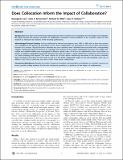Does Collocation Inform the Impact of Collaboration?
Author(s)
Kohane, Isaac; Lee, Kyungjoon; Brownstein, John S.; Mills, Richard G.
DownloadLee-2010-Does Collocation Inform the Impact of Collaboration.pdf (3.684Mb)
PUBLISHER_CC
Publisher with Creative Commons License
Creative Commons Attribution
Terms of use
Metadata
Show full item recordAbstract
Background
It has been shown that large interdisciplinary teams working across geography are more likely to be impactful. We asked whether the physical proximity of collaborators remained a strong predictor of the scientific impact of their research as measured by citations of the resulting publications.
Methodology/Principal Findings
Articles published by Harvard investigators from 1993 to 2003 with at least two authors were identified in the domain of biomedical science. Each collaboration was geocoded to the precise three-dimensional location of its authors. Physical distances between any two coauthors were calculated and associated with corresponding citations. Relationship between distance of coauthors and citations for four author relationships (first-last, first-middle, last-middle, and middle-middle) were investigated at different spatial scales. At all sizes of collaborations (from two authors to dozens of authors), geographical proximity between first and last author is highly informative of impact at the microscale (i.e. within building) and beyond. The mean citation for first-last author relationship decreased as the distance between them increased in less than one km range as well as in the three categorized ranges (in the same building, same city, or different city). Such a trend was not seen in other three author relationships.
Conclusions/Significance
Despite the positive impact of emerging communication technologies on scientific research, our results provide striking evidence for the role of physical proximity as a predictor of the impact of collaborations.
Date issued
2010-12Department
Harvard University--MIT Division of Health Sciences and Technology; Massachusetts Institute of Technology. Computer Science and Artificial Intelligence LaboratoryJournal
PLoS ONE
Publisher
Public Library of Science
Citation
Lee, Kyungjoon, John S. Brownstein, Richard G. Mills and Isaac S. Kohane. "Does Collocation Inform the Impact of Collaboration?" (2010) PLoS ONE 5(12): e14279.
Version: Final published version
ISSN
1932-6203